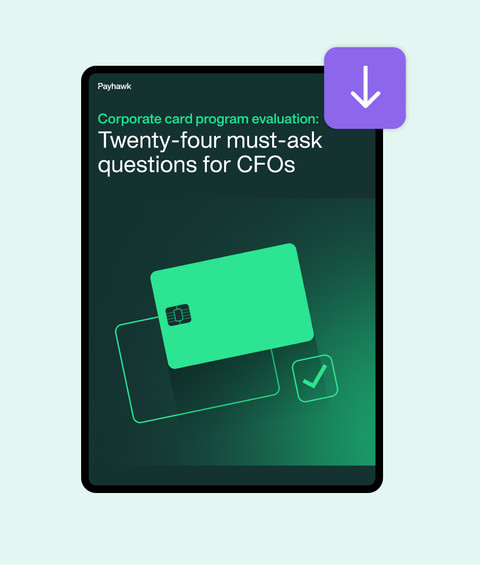
New CFO checklist: How to nail your first 90 days



As a CFO, you know that to be successful in your new role, you’ll need to use razor-sharp planning and execution backed by a growth mindset. Go through our detailed checklist to uncover the processes, systems, and solutions that will help you transition smoothly to CFO in your first 90 days on the job.
By submitting this form, you agree to receive emails about our products and services per our Privacy Policy.
You've taken on the CFO role; you're excited to get started, but you know it'll be a lot of work. The pressure's on, and the stakes are high. as you know, your responsibilities listed as a newly appointed CFO are never-ending (same as the list of laws and regulations CFOs need to follow).
What's more, the CFO role is changing and becoming more complex, strategic, and collaborative. Here are some statistics to illustrate the real pressure CFOs have to face on the daily in 2024:
Ninety-three percent of CFOs say their assigned duties feel much more significant than in the past. While 67% of CFOs fall into analysis paralysis because of the number of decisions they've got to make and the plethora of choices.
As an international fintech, we've helped countless CFOs control spend, manage expenses, and make smart cashflow decisions at Payhawk. And now, we've pulled together our top CFO insights for this CFO transition checklist. Discover the moves you should make to thrive in your first 90 days on the job, plus find tried-and-tested ways to set your company up for long-term success.

Phase one - Understanding the role of a CFO
Before making changes, it's critical to understand the business's processes, systems, goals, and resources and their effectiveness. Let’s focus on some ways to get acquainted.
1. Define the critical priorities for the first 90 days
First up on the new CFO checklist is a deep dive into the business to establish what to tackle first. Note the projects and initiatives that push the company forward and any pressing issues.
Here are some analytical considerations to make by category:
Strategic objectives and goals
The company’s objectives and targets are a guiding light for developing financial strategies and processes that succeed. Ask:
- What are the company’s strategic objectives and goals?
- What projects and initiatives will we implement to accomplish these goals?
- How do we track progress toward these objectives and goals?
Business operations
Another point on the new CFO checklist is evaluating the company’s setup. Learn how the company makes money, adds value to customers, and manages its resources. This information is helpful for financial planning, resource allocation, and performance management.
Check:
- What business model is the company most invested in, and how does it make money?
- What is our core product or service line, and how do we deliver it to our clients?
- What products/services are not working well for the company (cash drainers)?
- What techstack and financial systems support operations, and what integrations are in place to support your spend management system?
Market positioning
As we see from companies like Dove, Coca-Cola, Walmart, and Amazon, it’s not just the product that drives sales. It's also how the brand differentiates itself from the competition. Understanding industry trends, competitors, and market dynamics will help identify competitive threats and growth opportunities.
Some questions to ask are:
- Who are our main competitors, and what makes our company different from them?
- What key trends are molding the industry we serve?
- What are the company’s market strengths, weaknesses, opportunities, and threats?
Financial performance
Another critical to-do on the new CFO checklist is analyzing the company’s numbers. These insights will reveal the company’s financial health and capital structure. We’ll dive deeper into the figures later, but here’s a snapshot of things to consider:
- How has the company’s financial performance been over the last five years, and what have been the key drivers?
- What are the company’s financial strengths and weaknesses?
- Are we planning or executing any acquisitions, expansions, or divestitures that could affect the company’s finances?
Customers
It’s easy to assume who your customers are. This scenario is so common that 82% of marketers don’t know their target audience. Discovering your customer base's true identities will improve customer acquisition, profits, and more.
So, ask:
- Who are our current customers, and do they differ from our target customers?
- What are our customers’ wants, needs, and preferences?
- How are we acquiring and retaining customers, and are the approaches effective?
Business structure and culture
As you know, many things go into how an organization works, from remote working to bottom-up structures. These traits impact everything. Know what you’re walking into by asking:
- How is the company structured, and how do we make and communicate decisions?
- What’s the culture like, and how does it affect employee engagement and performance?
- What are some ingrained cultural norms and values?
Technology
Technology is becoming increasingly important for companies to succeed. The problem is that over 70% of finance digital transformation projects move slowly. Also, just 30% of such projects succeed.
As a CFO, you’ll lead the digitalization charge in the finance department. Studying your company's technology will reveal which projects to launch, tweak, and cull. Ask:
- What are internal stakeholders' opinions on the company’s tech setup?
- What role does technology play in operations and strategic projects?
- Are any ongoing technology projects critical to the company's success?
Talent management
Did you know that only 41% of employees perform at their peak? That’s a lot of lost productivity, costing businesses $8.8 trillion each year globally. So, hiring and retaining top finance talent will be part of your CFO responsibilities list. Analyzing your staff's capabilities will reveal gaps in skills and resources. It'll also guide talent development, team structuring, and succession planning.
Consider:
- How well does our talent management strategy align with the company’s objectives, goals, and overall strategy?
- Do we have gaps in our talent pool? If so, where and why?
- How effective are our processes in attracting and retaining top talent?
- What can we automate in terms of financial processes in order to free the finance team from admin – and empower them to focus on important initiatives?
Risk management and compliance
Legal and regulatory changes are critical for CFOs and even more complex since the advent of AI, blockchain, and Robotic Process Automation (RPA). So, two huge tasks on your new CFO checklist are managing risk and compliance. Worryingly, 72% of CFOs say their compliance and risk management practices and processes haven’t kept up with the fast-changing landscape. So, evaluate risk and compliance controls and processes to expose vulnerabilities by asking:
- What are the critical regulatory and compliance obligations the company must fulfill?
- What processes and systems ensure adherence to the rules and timely updates?
- What (cyber)security and data protection solutions and initiatives are in place to prevent incidents?
- What will our own security and spend policies look like and how can we successfully roll these out in a way that ensures compliance?


2. Analyze the organization's financial health
Now that you have some foundational company knowledge, you can peel back the hood on the company’s finances and get into the mechanics of its money.
Review financial statements
Examining the actuals, balance sheet, cash flow statement, and income statement will unveil the company’s financial performance. Watch for trends and anomalies to investigate further.
Look into the company’s profitability
For some businesses, profitability may be a low priority. However, knowing whether the company is in the red or green is helpful for budgeting. So, analyze profits by segment, product, and geography.
Zoom in on liquidity and solvency levels
Uncover the company's financial viability and available cash by analyzing its current, quick, and debt-to-equity ratios. Also, look at cash flow metrics like:
- Cash conversion cycle
- Current accounts receivable and payable
- Operating cash flow
- Days of sales outstanding
- Gross profit margin
Check working capital levels and solutions
Cash flow management is the lifeblood of every business, but the stream can run dry. In 2023, 89% of CFOs said they needed more liquid capital. Also, 86% of CFOs believe financing plays a role in securing favorable capital for new initiatives. Eighty-five percent used funding to protect their business from macroeconomic events.
So, working capital check-ups will be part of your new CFO checklist. Look at:
- Cash flow projections
- Accounts payable, accounts receivable, and inventory turnover ratios
- The company's access to affordable funding
Assess the company’s capital structure
A clear picture of the company’s financial structure will reveal its economic stability and ability to afford growth opportunities. Note areas in which you can optimize the capital structure to reduce risk, enhance shareholder value, and increase profits as you dig into the following:
- Debt Ratio
- Equity Ratio
- Debt-to-Equity Ratio
- Weighted Average Cost of Capital
- Debt Service Coverage Ratio
- Interest Coverage Ratio
- Debt levels
- Cost of capital
- Capitalisation mix (considering the company's circumstances and market trends)
Next, compare your company’s capital structure to that of its competitors. This evaluation will reveal your competitors’ market stature to identify opportunities and vulnerabilities.
Analyse market prospect ratios
Another task on your CFO transition checklist is to assess the company’s operating efficiency, asset utilization, profitability, and shareholder value creation. From here, you can identify ways to improve them. Some ratios to concentrate on include:
- Return on equity
- Return on assets
- Earnings per share
Look over budgets and forecasts
Next, review those almighty budgets and forecasts. You'll uncover how well the company has aligned spending to achieve its goals. You'll also identify scaling opportunities and challenges.
Pay attention to:
- Planned versus actual expenses
- Issues uncovered in previous audits
- Audit trail preparedness
- Correctness of past forecasts
3. Establish relationships with key stakeholders
“You never get a second chance to make a first impression”, as the saying goes. So, put your soft skills to work as you tackle the next job on the new CFO checklist: building relationships.
Establish yourself as a leader by introducing yourself and your expertise. Also, learn more about the company.
This stage could involve:
- Seeking feedback from stakeholders on the company’s financial goals, strategies, processes and solutions
- Encouraging transparent discussions and communication
- Enquiring about the achievements of past CFOs and how you can build upon them
- Learning the wants, needs, and expectations of each stakeholder group
Top tip: If this isn’t your first rodeo, reflect on your past CFO roles to uncover strategic moves to make and mistakes to avoid.
Hear from Hristo Borisov, CEO at Payhawk, in the video below as he shares tips on how scaleup CFOs can demonstrate good cash flow management, & more.
Phase two - Preparing for the transition
Phase One was a lot of number-crunching. Let's switch things up by tackling another task on the new CFO checklist: evaluating administrative processes in the finance function.
1. Conduct a comprehensive review of existing processes and systems
There are many roles you'll need to assess. But to start with, look into the following:
Financial planning and analysis (FP&A)
Admin is holding many finance teams back. Twenty-four percent find the battle against manual labor and time-intensive processes a key challenge. As part of your new CFO responsibilities list, you'll need to check FP&A’s efficiency and consistency. For example, you could:
- Review policies and procedures for accuracy, efficiency, and completeness. Note any productivity and accuracy drivers, plus bottlenecks and administrative burdens
- Assess the frequency of forecast optimizations (36% of CFOs’ FP&A teams adjust their projections at least once a week)
- Consider how well forecasts, analyses, and budgets align with and support company goals
- Test your finance techstack, including expense management software, FP&A, ERP providers, and more. Look at functionality, reliability, and integration capabilities
- Evaluate the relevance and usefulness of (key performance indicators) KPIs and metrics
Expense management, accounting, and cash flow management
Overseeing expenses, accounting, and cash management are mission-critical tasks on your new CFO checklist. But with the manual approach to spend management, your team will be knee-deep in admin, wasting time and money.
For example, the average employee spends 20 minutes creating an expense report1.5 times a month, costing $58 each time. Additionally, corrections take a further 18 minutes per report and cost $52 on average. Check your company's financial practices to ensure they are up to scratch.
To negate this, you can:
- Review expense policies and spend control tools to gather how the company accrues, authorizes, records, and reconciles expenses
- Test the expensing and accounting policies for clarity, comprehensiveness, and consistency
- Check reliance on paper-based processes and solutions compared to digital ones. E.g., how often teams use Excel-based spend tracking and paper receipts versus automated reconciliation software
- Similar to the above, also check the effectiveness of your current setup, as even if you are working digitally, you may have got to a position where you use multiple disconnected tools instead of one that can give you complete and centralized control over business spend
- Scope out historical expense data to spot spending trends and outliers. Note any overspending, non-compliance, and inefficiencies
- Analyse spending patterns and vendor payment terms to pinpoint cost-reduction and cash-flow optimisation opportunities
- Examine the efficiency and effectiveness of the company’s liquidity management, cash management, and treasury practices and solutions
Risk management and compliance
Risk comes from all angles, from sticky-fingered cyber criminals to unresolved legal problems. Such issues have become common, with devastating financial losses. Get this:
- CFOs see geopolitical issues as the biggest risk to their business in 2024
- Thirty-six percent of global finance leaders recorded losses of $1 million and up for data breaches in the last three years
- Forty-one percent of finance leaders believe not achieving sustainability goals poses a moderate or severe risk
- Forty-nine percent of CFOs say cyber risk disclosure requirements are most appealing
- Forty percent of businesses don’t complete a yearly compliance risk assessment
So, check whether your risk and compliance processes are fruitful:
- Consider the effectiveness of the risk identification, mitigation, and compliance strategies
- Review existing risk management and governance structures and literature for accuracy
- Check compliance with accounting standards and regulatory requirements
- Analyse the company’s risk culture, noting behaviors, attitudes, and awareness among staff
- Assess the company’s technology, cybersecurity, and data security protocols
2. Identify immediate challenges and priorities
The next job on your CFO transition list is to build a list of essential tasks to tackle over the next three to six months. Gather the issues you spotted throughout the evaluations to compile the list.
Rank the tasks in order of impact if not addressed. If you need more clarity:
- Conduct stakeholder interviews to identify the issues they’ve noticed need immediate attention. Include staff at all seniority levels
- Let the numbers decide for you. For example, say sales have dipped for a former top-selling product, but its expenses have increased. Prioritising a relaunch could help you hit targets
- Conduct external market analysis. E.g., a commissioned report on competition and pricing pressures to reveal the impact on the company's market share and profits
3. Evaluate the current financial reporting and analysis practices
Chaos could soon follow if teams are stuck crunching numbers in Excel and forwarding sensitive information via unencrypted comms channels. So, you'll want to know about risky and time-consuming practices and stop them. For that:
- Review audit findings
- Examine record-keeping for accuracy and efficiency
- Spot-check expense reports and analyses for accuracy, completeness, and compliance
- Check for automation adoption and its impact
- Note whether the practices meet Generally Accepted Accounting Principles (GAAP) or International Financial Reporting Standards (IFRS)
Unlock better financial controls: Explore expense management with Payhawk

Phase three - Building a strategic plan
You've laid the foundation; now it's show time. Next up on your new CFO checklist is to uplevel the finance function. Here’s how:
1. Develop a roadmap for the finance function
Assess the finance function’s current state
Write a short report on each finance function role using the data from your phase one and two evaluations. Pinpoint gaps in systems, processes, reporting, metrics, technology, and skills. Also, note what’s working that you’d like to build upon.
Clarify strategic objectives and priorities
To get priorities and ambitions in sync, align the list of high-priority tasks with the company’s goals. Identify what you need to achieve them, including KPIs. For example, imagine your company wants to increase productivity by 30% in 6 months. You've noticed that manual tools and processes cost the bookkeeping team 17 hours weekly. You could set a KPI to decrease bookkeeping admin by six hours in six months using automation and staff retraining.
Optimise your department structure to drive employee happiness and growth
Did you know that 66% of workers struggle to keep up with the ever-changing skill requirements? Such issues lead to high employee disengagement and churn. So, supporting staff is on your new CFO transition list.
Outline the skill sets in your finance department. Then, map out a team structure that maximizes skill utilization and provides optimal staff levels to reduce burnout. Also, provide relevant and personalised training to help staff advance. It’ll be worthwhile. Companies with a highly engaged workforce are 23% more profitable and 18% more productive.
Upgrade systems and processes
You’ll need to streamline and digitise systems and processes to improve the finance function's results. For example, imagine your finance team is battling paper receipts, digital invoices, clunky software, and email chains to reconcile purchase orders, which causes costly errors. To reduce admin, you could launch spend management software that supports real-time reconciliation and features multi-functional benefits like corporate cards, expense management, subscription management, card controls and approval flows. Accounts payable, PO, and more.
And don’t forget to prioritise quick wins. For instance, if you’ve worked as a CFO previously and a strategy, process, or technology drove significant wins, see how you can replicate it in your new company.
Leverage automation
Automation is one of the latest technologies to take over the finance world, and for good reason. It allows teams to reclaim precious resources and become more productive.
Knowing this, implementing automation is an essential task on your new CFO checklist. Start with transactional activities like accounts payable, accounts receivable, expense management, vendor management, and financial reporting. But don’t stop here.
Technology can fully automate 42% of finance tasks and partially automate another 19%. You can also use task automation solutions like RPA to seize around a third of the opportunity in finance.
Create ironclad internal controls
Protecting the company’s funds and reputation is vital for long-term success. Update your internal controls, including compliance, audit, risk management procedures and policies by:
- Aligning internal controls with industry best practices
- Segregating duties
- Enhancing overseeing, approval, and whistleblowing processes
- Using current issues and past company or market incidents and issues to guide changes
Remember to communicate your new approach to internal stakeholders. Provide ongoing training to increase adoption and effectiveness. Finally, monitor progress, adjust strategies, and hold staff accountable where necessary.
2. Align financial goals with the overall organisational strategy
When making changes, it's easy for the financial and organisational strategy to become misaligned. For instance, if your company plans to grow headcount and you don’t adjust the hiring and training budgets, execution will become more complex. So, ensure you understand the company’s strategy across departments. Then, work with senior management to connect the strategic objectives and financial goals, set KPIs, and back the goals with enough budget.
3. Incorporate modern finance technology for efficiency and accuracy
Modern technology is now the finance function's trusted sidekick, helping staff succeed. However, only the best tools will do in this rocky financial landscape. So, another task on your CFO responsibilities list is to find comprehensive, high-tech solutions.
AI-backed tools are great examples. Eighty-eight percent of CFOs already use them or are trying to. Additionally, 70% will integrate AI into their finance processes in the coming year. For example, Explose uses our AI camera, OCR technology, expense management software, and virtual corporate cards to make accounting easier.
At Payhawk, for example, you can capture receipt and invoice data with our solution (and empower your spenders to categorise the spend with categories and custom fields) in seconds and empower employees to complete their own project expenses. The team can now spot duplicate invoices quickly and auto-populate multiple fields, saving time and energy. Our customer Explose shares that they have slashed two hours of admin from their workday thanks to this.


Phase four - Overcoming challenges and roadblocks
You’ve studied the company, scoped out the competition, created financial goals, and launched your strategy — nice work. One of the other jobs on your new CFO checklist? Putting out fires. Let’s review some flame-extinguishing (and, even better, fire-prevention tips).
1. Address potential obstacles in the transition period
“Prevention is better than cure”, as the saying goes. Knowing this, before kicking off changes, sit down with each team in your department. Brainstorm problems that could arise and then create ways to mitigate them. For example, if the tax team worries that inadequate expense management x ERP integrations might lead to data accuracy issues with VAT. You could:
- Use data mapping and standardization to create a structured approach to feeding data
- Test data accuracy regularly to ensure the integrations are working well
- Check back in with your current providers to see how the integration operates day-to-day and how it was set up. At Payhawk, for example, our integrations are built based on specific business requirements and in accordance with the accruals concept. Our direct integration with ERPs like NetSuite lets you connect accounting categories, custom fields and values, VAT rates, and vendors, making the data flow seamless and transparent
2. Implement strategies to manage change effectively
Overseeing change is essential to reduce disruption and make achieving targets simpler. Here are some ways to go about it:
- Share the reasons for the changes and the expected benefits with stakeholders and get their buy-in
- Provide regular and transparent updates to stakeholders and answer questions quickly
- Set realistic timelines and expectations for the changes
- Provide adequate training, resources, and support to staff
- Identify resistance to change and address concerns early
3. Ensure compliance and mitigate risks in financial operations
Your compliance and risk management strategies will determine whether your finance goals fly or flop. So, put your best foot forward.
- Build on existing best practices
- Conduct comprehensive risk and compliance assessments and make findings actionable. Repeat these assessments often
- Set clear ownership for specific duties
- Get external expert opinions periodically to stay updated on emerging issues
- Update policies and processes as developments arise. E.g., if the severity of a risk changes
Phase five - Measuring success and making an impact
To ensure your strategy and execution work well, building a performance tracking system is also part of your new CFO checklist. Specifically:
1. Establish key performance indicators for financial performance
To achieve success, your team needs to know what this looks like and how to attain it. That’s where KPIs come in. For example, you could:
- Match KPIs to the company's financial goals
- Attach KPIs to strategic drivers. E.g. connecting the KPI revenue growth to market expansion, product innovation, or customer acquisition
- Implement technology, systems, and processes to track metrics and measure financial performance
- Balance financing and non-financial metrics to provide a holistic view of performance
- Split KPIs by departments, product lines, or roles to gain more granular insights into performance
2. Track progress and adjust strategies accordingly
Ensuring everyone stays on track is another crucial job on your new CFO checklist. Here are some ways to do it.
- Regularly review the company’s financial performance using KPIs and industry benchmarks
- Observe trends to understand what drives or hinders each team’s performance
- Join forces with cross-functional teams to make strategy tweaks to reach the set goals
- Set up a monitoring and reporting process to quickly identify and address problems
3. Make a positive impression in board meetings and with external stakeholders
Building strong ties with external stakeholders will make executing your new CFO transition list easier. Your empathy and relationship-building skills will be handy here.
- Be transparent about the company’s financial performance and strategic initiatives
- Encourage dialogue and feedback
- Network with stakeholders often


How can Payhawk help you transition into your CFO role?
With so many solutions on the market, you might wonder what makes Payhawk ideal for your CFO journey. Let’s find out.
Enhance financial operations with card linking and real-time card feeds
Most companies have well-established corporate card programs in place, where they've built a good relationship with their bank for a long period of time. That's why, businesses are often reluctant to give away their existing cards. This is where card linking and real-time card feeds can significantly enhance financial management accuracy and efficiency. This technology records, captures and categorizes transactions instantly, removing the need for manual receipt handling and data entry. Employees can submit expenses immediately, thanks to real-time transaction notifications linked to corporate cards and OCR technology that automates categorization. This process not only streamlines reconciliation but also reduces manual labor. Additionally, the seamless two-way real-time sync with ERP systems ensures consistent, up-to-date financial data across platforms, regardless of the card provider. This method gives CFOs an accurate, real-time financial overview, improving strategic decisions and minimizing errors.
Physical receipt and invoice scanning
Say goodbye to processing paper receipts and incorrect submissions. Our AI camera, OCR technology, custom accounting fields and categories empower employees to submit digital and correct expenses painlessly.
Expense budgeting, tracking, and categorization
Set and control budgets fuss-free with our corporate cards. Get globally accepted cards with customisable spending controls (like card freezes and ATM blocks), limits (around things like daily spend, and more), and approval workflows (for fund requests etc). You can also take advantage of automated reconciliation and categorization based on predefined criteria like expense type or project.
Approval workflows
No more time-consuming back and forth to get expenses signed off. Accelerate approvals with our custom approval workflows for different expense types, streamlined approval chains for expense reports, and even features to sub in approvers based on colleagues' OOO statuses.
Automated accounting and month-end closing
With our accounts payable automation, you can speed up invoice payments and leverage procure-to-pay features. You can also leverage an invoice-matching mailbox and multi-entity management solutions for standardised recordkeeping and a quick month-end close.
Seamless accounting and ERP integrations
Not to be a broken record, but at Payhawk, we built our integrations around the CFO's needs. This approach means our integrations are built in accordance with the accruals concept (something that sets us apart from most of our competitors) and cover the following:
- Expenses are exported as soon they're marked as reviewed
- We export all payments in real-time once settled
- We don't use journal entries; using native objects instead
- You can correct mistakes fast with a smart expense recall feature
- Month end close is faster and more efficient (See our customer Essentia Analytics who halved their close time!)
- Reconciliation is quicker, and more seamless than ever
Automated reconciliation
Do you want to end sluggish reconciliations and admin errors? Use our corporate cards and connected expense management software plus seamless ERP integrations to get complete automated reconciliation.
Take our customer, MDM Props, for example. They faced difficulties managing company cards, expenses, and accounting with separate tools. However, after switching to Payhawk for cards, expense management, and a seamless integration with Sage, they found they saved over 32 hours per week on card reconciliations.
Fraud detection solutions
Our fraud detection and prevention tools keep your company safe without adding to your team’s workload. For example, Payhawk links to over 50 HRIS providers, reducing fraudulent activities, automating data syncing, and simplifying onboarding — for instance, auto-closing cards when an employee leaves.
Subscription management
Is your team managing subscriptions through email receipts and Excel? Simplify how you track recurring payments and usage to find duplicates, check for spend fluctuations, and more to optimise spending and avoid overspending.
Carbon emissions tracking
Do you have sustainability targets to measure and meet? Our carbon-tracking features, which span data collection and carbon accounting to make these jobs a breeze.
Money- and time-saving benefits
At Payhawk, we ensure your company's funds stretch further through cashback, VAT reclaims, 0% FX rates on seven currencies, and blocking non-compliant purchases. Our technologies also make managing finances quick and easy.
Take our German customer ATU, for example; Mathias Goetz, Senior Project Manager, explains:
We no longer have to chase receipts. Since using Payhawk, managers must simply take a picture of their receipt — thus digitizing it — and enter it into the automated finance system. In the first year, this change resulted in ATU recouping €2 million from the tax office that would have otherwise been lost.
Become the next CFO rockstar
Being a CFO is a huge job with many moving parts. But there are plenty of CFO rockstars out there, and you could be the next one. Approach your CFO responsibilities list systematically and adopt innovative technology early on.
Stay informed about the best tools and strategies to optimize your finance department, and don’t be afraid to pivot when numbers and circumstances dictate. Also, keep your team’s buy-in at the forefront of your decisions and stakeholders in the loop to foster strong relationships that drive your vision forward.
Finally, don’t go it alone. Get training, network, and join communities to find like-minded peers. You’ve got what it takes. Now, take your new CFO checklist and make your dreams a reality.
Want to learn more about seamless spend management from Payhawk? Book a demo with one of our experts today.
Trish Toovey works across the UK and US markets to craft content at Payhawk. Covering anything from ad copy to video scripting, Trish leans on a super varied background in copy and content creation for the finance, fashion, and travel industries.
Related Articles


Purchase Orders 101: What are they and how do they work?

